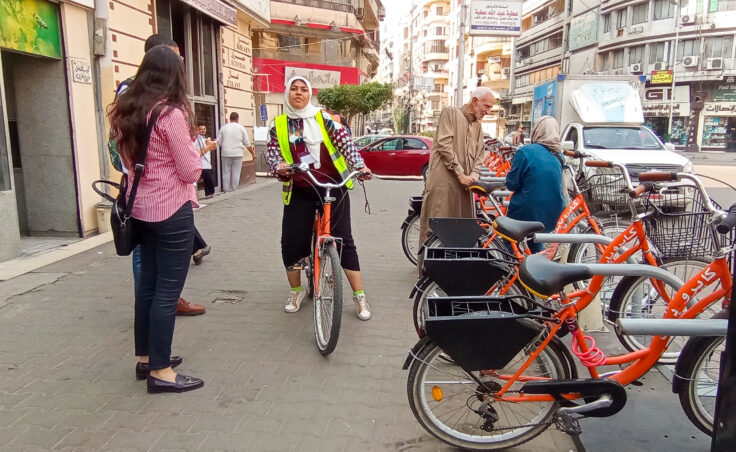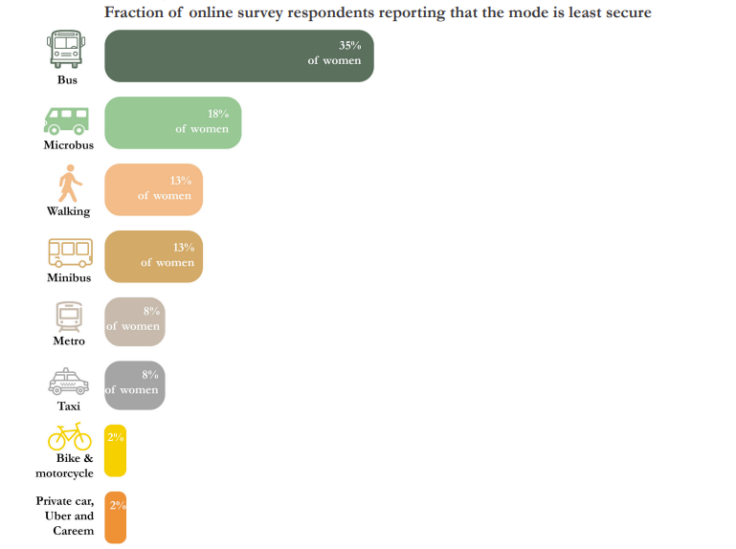May 22, 2023
Challenges and Opportunities for Gender-Equitable Transport in Cairo, Egypt
As in many aspects of daily life, transport systems generally reproduce existing power structures in which gender inequalities in access and safety persist.
According to UN studies, 86% of Egyptian women have reported feeling unsafe on public transport.
We know that transport planning is not gender-blind, and it adversely impacts women and girls’ access to economic opportunities, education, employment, healthcare, and more. The global pandemic has had a far-reaching impact on public transport systems that were already stretched too thin, and further exacerbated the inequities faced by women and girls that are dependent on these networks for mobility and independence. As cities seek to rebuild confidence and trust in their public transport, a vital component of this effort is ensuring that the physical, social, and operational infrastructure of their systems is more responsive to the needs of women, girls, and all types of communities.
For transport agencies and planners to re-envision their transport in a post-pandemic world, it is critical to have more data and perspectives on the barriers, challenges, and opportunities for advancing equity and access for all commuters. ITDP Africa, in partnership with the New Urban Communities Authority (NUCA), UN Women, and UN-Habitat undertook a comprehensive study of gender equity in public transport in Cairo, Egypt to collect important data for better assessing the needs and challenges of women and girls on their commutes. This also included an exploration of gender-sensitive design scenarios for a planned bus rapid transit (BRT) corridor in Greater Cairo that will improve connectivity between the 6th of October City and Giza — a key opportunity to pilot more inclusive strategies within the new system.

In Cairo, as in many large metropolitan areas, women use public transport more than men and are more dependent on it, having less access to private vehicles. However, using public transport can often take more time and offer less choice in terms of services and routes that can make trips more arduous, more circuitous, and costlier for women — particularly if the systems are not well integrated with other modes like cycling and walking. Public transport also presents the unfortunate reality of physical and verbal harassment for women and girls on a regular basis. According to UN studies, 86% of Egyptian women have reported feeling unsafe on public transport, a concerning statistic given that an estimated 25% of public transport users are women in Cairo. Issues of efficiency, cost, design, and safety disproportionately impact the ability and well-being of women and girls on these essential commutes.
This study from ITDP and partners utilized a number of methods for data collection to ensure that it captured an inclusive and diverse range of transport users to help inform potential solutions. This included:
- A public transport terminal survey that assessed women’s travel patterns and preferences by collecting sex-disaggregated data;
- Focus group discussions aimed at capturing information on women’s lived experiences while commuting;
- An online travel pattern survey of commuters that garnered 2,500 responses;
- Operator assessments that explored the level of gender awareness among transit employees and operators;
- A frequency-occupancy survey that recorded the number of men, women, and children on a sample of public transport vehicles; and
- A non-motorized transport (NMT) facility survey that examined the quality of the walking and cycling environment at representative locations along planned BRT corridors.

In Cairo, a majority of women surveyed reported spending two hours or more on public transport for daily commutes, despite issues of safety and harassment.
The study revealed several key findings, including that Cairo’s women generally make more diverse trips with more varied destinations compared to men, spending a reported two hours or more on the average commute. While concerns about safety and reliability of public transport are high, the study also found that women’s choice of transport modes are often limited by cost and access. As a result, a large number of women in Cairo need to depend on public transport for daily life, despite facing harassment, feelings of insecurity, and inefficiencies in the system. More than 80% of women surveyed reported experiencing harassment at some point in their commutes, with a significant number (35%) pointing to Cairo Transport Authority buses as being the least secure due overcrowding and the lack of gender-segregated spaces. Unfortunately, more than 60% of women reported facing physical harassment, and even more reported verbal harassment, with transit operators even being complicit or ignoring many incidents.
To tackle these issues, a broader and more intersectional approach is needed that not only provides safeguards on transit vehicles themselves, but also takes measures to protect and empower women in public spaces, whether they are walking to the metro, sitting on a bus, docking a bicycle, or any step in between. The report proposes several solutions and recommendations for improving Cairo’s transport to be more responsive and reflective of these gender and safety needs — concepts that can be useful for all types of cities. This includes:
- Women-only sections and compartments on vehicles — 90% of women surveyed believe that public transport should have separate cars for women and dedicated seating areas;
- Stations and terminals designed with security in mind — Stations and waiting areas should have good lighting, transparent and visible frontage, security cameras, and provide accessible and integrated amenities for women, caregivers, the elderly, and people with disabilities;
- Streets should be upgraded for access and connectivity — Streetscapes in and around transit should have continuous footpaths, safe at-grade crossings, and dedicated cycle facilities. Pedestrian facilities need to satisfy universal access standards that make commutes simpler, more direct, and more protected for everyone;
- Promoting more mixed-use development — As a longer-term strategy, public transport corridors with more diverse commercial and residential spaces can help increase perceptions of security and reduce opportunities for crime and harassment;
- More robust public safety reporting, enforcement, and communications — More commitment from law enforcement and transport agencies to gender protections, including reporting systems for harassment with clear penalties, can help make women feel safer. Transit personnel, operators, and fellow commuters should be trained to respond to complaints and prevent incidents, utilizing a communications strategy that builds awareness of forms of harassment and encourages others to play an active role in safety.
- Provide more opportunities for women in transport jobs — The system should aim to have women occupy 50 percent of jobs in areas such as ticketing, driving, mechanics, management, and beyond to ensure visibility, representation, and participation at all levels.

ITDP, NUCA, UN Women, and UN-Habitat undertook this study to help inform officials, planners, and decision-makers seeking to improve the quality, comfort, and ridership of the Cairo’s transport systems. As cities around the world assess the future of their own public transport, particularly in light of the inequities and faults exposed by the recent pandemic, it is important that gender inclusion and considerations for marginal communities be placed at the forefront. It is possible to develop strategies and institutionalize solutions that place safety and accessibility at the core of public transport planning to ensure that women and girls have confidence and trust on their commutes.
For Greater Cairo, the proposed BRT system presents one such window of opportunity to take data-driven gender concerns into account when designing future service plans and infrastructure. Addressing the challenges faced by Cairo’s women requires joint efforts by regional and city agencies to plan, develop, and manage a more secure and user-friendly system. Local agencies should work to ensure that physical designs and operations are reflective of diverse needs, especially those of women, children, and caregivers. The system should also help educate commuters with anti-harassment resources, create more standards for employing women, and implement safer, more accessible vehicles, terminals, and street environments. These studies offer a foundation and provides much-needed perspectives, data, and recommendations that can guide transport strategies in Greater Cairo — and beyond — into the future.
